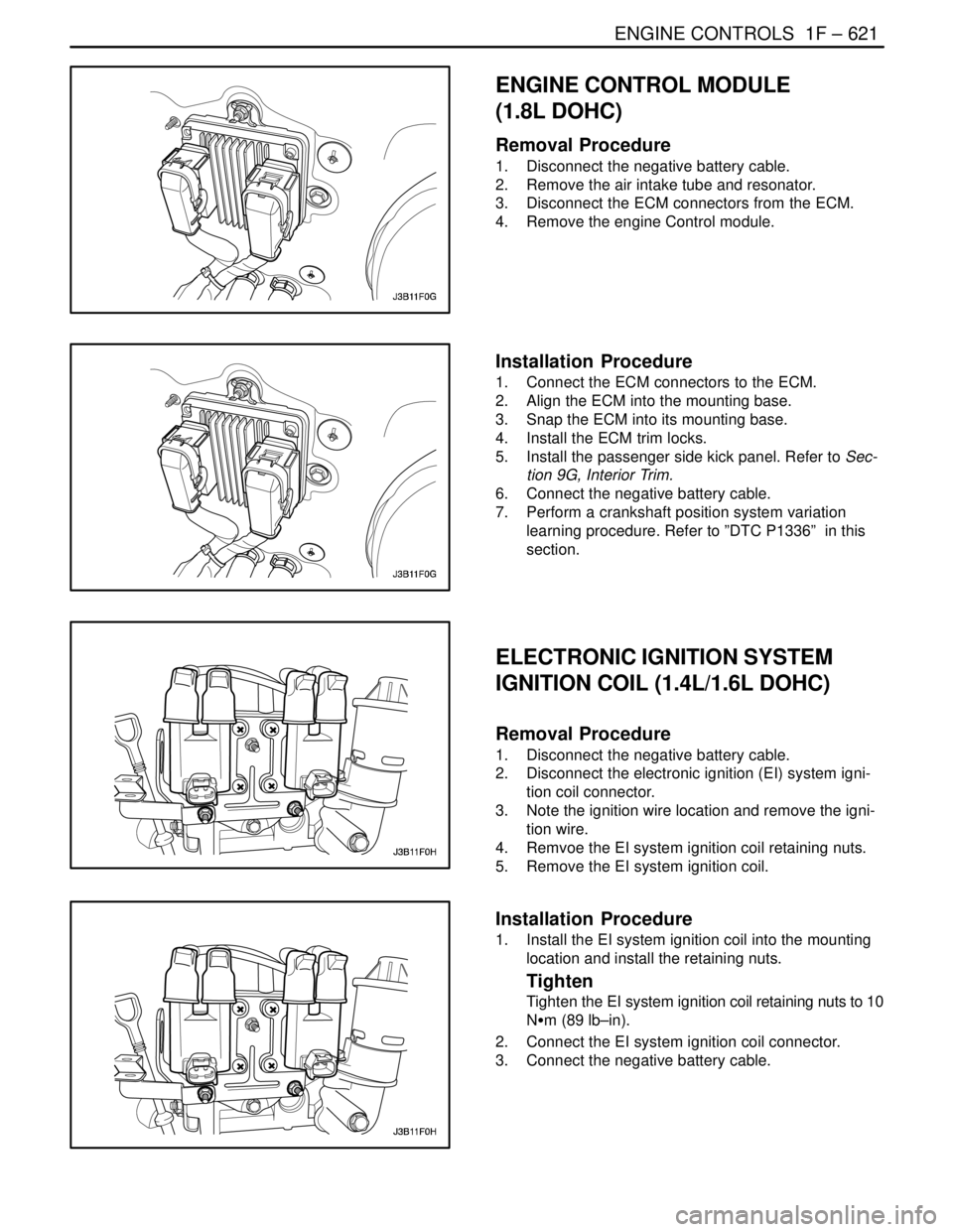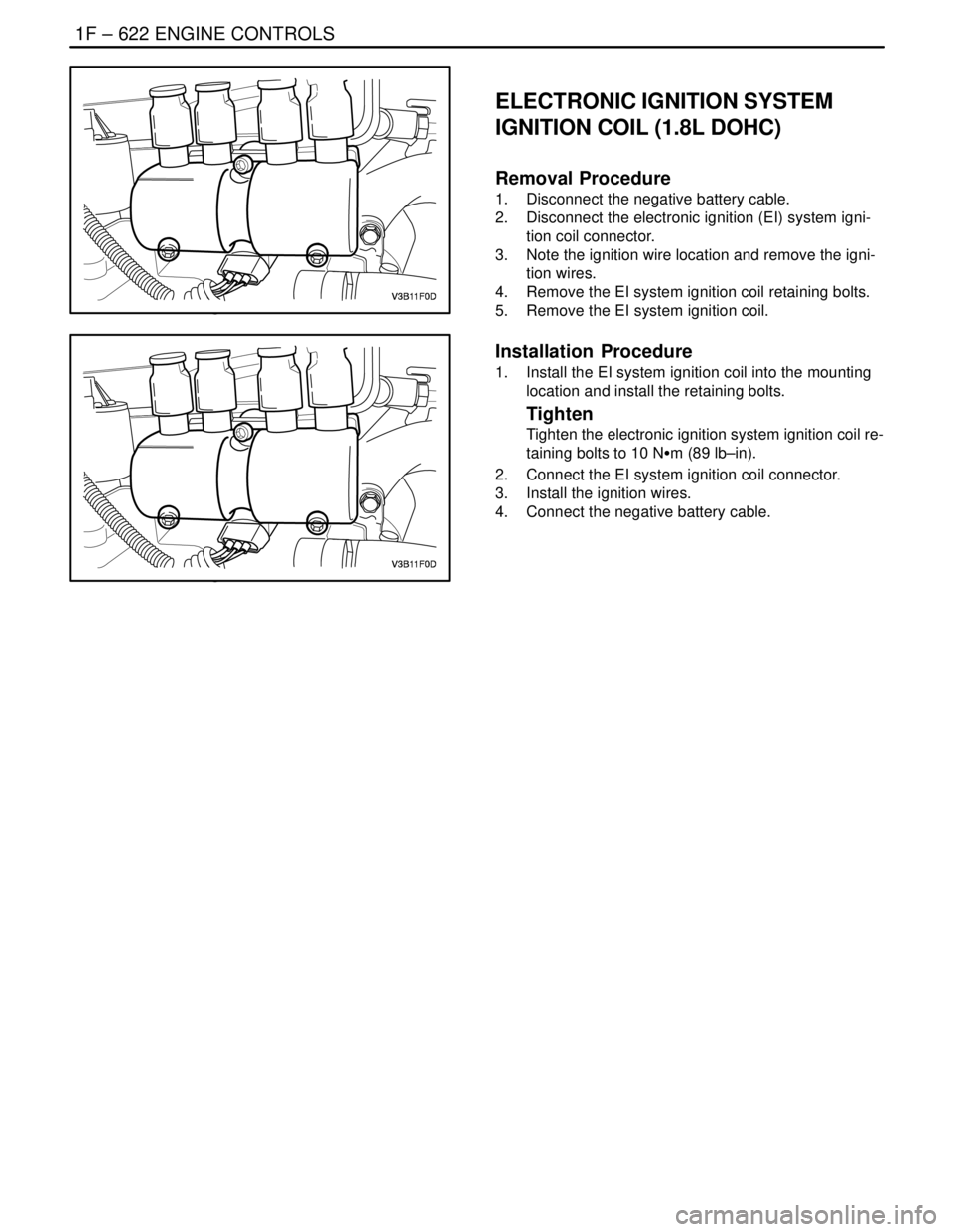2004 DAEWOO LACETTI battery location
[x] Cancel search: battery locationPage 777 of 2643

ENGINE CONTROLS 1F – 531
DAEWOO V–121 BL4
DIAGNOSTIC TROUBLE CODE (DTC) P1114
ENGINE COOLANT TEMPERATURE INTERMITTENT LOW
VOLTAGE
Circuit Description
The Engine Coolant Temperature sensor (ECT) is a
thermistor mounted in the engine coolant stream. The En-
gine control Module (ECM) applies 5 volt reference volt-
age through a pull–up resistor to the ECT signal circuit.
When the engine coolant is cold, the sensor resistance is
high, and the ECM will monitor a high signal voltage. As
the engine coolant warms, the sensor resistance is less,
and the ECT signal voltage measured at the ECM drops.
With a fully warmed engine, the ECT signal voltage should
measure about 1.5 to 2.0 volts. If the ECM detects an ECT
signal that is intermittently below the range of the ECT
sensor, Diagnostic Trouble Code (DTC) P1114 will set.
Conditions for Setting the DTC
S ECT is less than 149°C (300°F).
S Engine has been running for over 60 seconds.
Action Taken When the DTC Sets
S The Malfunction Indicator Lamp (MIL) will not illumi-
nate.
S The ECM will store conditions which were present
when the DTC set as Failure Records data only.
This information will not be stored as Freeze Frame
data.
S A history DTC is stored.
Conditions for Clearing the MIL/DTC
S A history DTC will clear after 40 consecutive warm–
up cycles without a fault.
S DTC(s) can be cleared by using the scan tool.
S Disconnecting the ECM battery feed for more than
10 seconds.Diagnostic Aids
Check for the following conditions:
S Poor connection at the ECM. Inspect harness con-
nectors for backed–out terminals, improper mating,
broken locks, improperly formed or damaged termi-
nals, and poor terminal–to–wire connection.
S Damaged harness. Inspect the wiring harness for
damage. If the harness appears to be OK, observe
the ECT display on the scan tool while moving con-
nectors and wiring harnesses related to the ECT
sensor. A change in the ECT display will indicate
the location of the fault.
S Reviewing the Fail Records vehicle mileage since
the diagnostic test last failed may help determine
how often the condition that caused the DTC to be
set occurs. This may assist in diagnosing the condi-
tion.
S Use the Temperature vs. Resistance Values table
to evaluate the possibility of a skewed sensor. Re-
fer to ”Temperature vs. Resistance” in this section.
Test Description
Number(s) below refer to the step number(s) on the Diag-
nostic Table.
1. The On–Board Diagnostic (EOBD) System Check
prompts the technician to complete some basic
checks and store the freeze frame and failure re-
cords data on the scan tool if applicable. This
creates an electronic copy of the data taken when
the malfunction occurred. The information is then
stored on the scan tool for later reference
Page 779 of 2643

ENGINE CONTROLS 1F – 533
DAEWOO V–121 BL4
DIAGNOSTIC TROUBLE CODE (DTC) P1115
ENGINE COOLANT TEMPERATURE INTERMITTENT HIGH
VOLTAGE
Circuit Description
The Engine Coolant Temperature sensor (ECT) is a
thermistor mounted in the engine coolant stream. The En-
gine control Module (ECM) applies 5 volt reference volt-
age through a pull–up resistor to the ECT signal circuit.
When the engine coolant is cold, the sensor resistance is
high, and the ECM will monitor a high signal voltage. As
the engine coolant warms, the sensor resistance is less,
and the ECT signal voltage measured at the ECM drops.
With a fully warmed engine, the ECT signal voltage should
measure about 1.5 to 2.0 volts. If the ECM detects an ECT
signal that is intermittently above the range of the ECT
sensor, Diagnostic Trouble Code (DTC) P1115 will set.
Conditions for Setting the DTC
S ECT is less than –38°C (–36°F).
S Engine has been running for over 90 seconds.
Action Taken When the DTC Sets
S The Malfunction Indicator Lamp (MIL) will not illumi-
nate.
S The ECM will store conditions which were present
when the DTC set as Failure Records data only.
This information will not be stored as Freeze Frame
data.
S A history DTC is stored.
Conditions for Clearing the MIL/DTC
S A history DTC will clear after 40 consecutive warm–
up cycles without a fault.
S DTC(s) can be cleared by using the scan tool.
S Disconnecting the ECM battery feed for more than
10 seconds.Diagnostic Aids
Check for the following conditions:
S Poor connection at the ECM. Inspect harness con-
nectors for backed–out terminals, improper mating,
broken locks, improperly formed or damaged termi-
nals, and poor terminal–to–wire connection.
S Damaged harness. Inspect the wiring harness for
damage. If the harness appears to be OK, observe
the ECT display on the scan tool while moving con-
nectors and wiring harnesses related to the ECT
sensor. A change in the ECT display will indicate
the location of the fault.
S Reviewing the Fail Records vehicle mileage since
the diagnostic test last failed may help determine
how often the condition that caused the DTC to be
set occurs. This may assist in diagnosing the condi-
tion.
S Use the Temperature vs. Resistance Values table
to evaluate the possibility of a skewed sensor. Re-
fer to ”Temperature vs. Resistance” in this section.
Test Description
Number(s) below refer to the step number(s) on the Diag-
nostic Table.
1. The On–Board Diagnostic (EOBD) System Check
prompts the technician to complete some basic
checks and store the freeze frame and failure re-
cords data on the scan tool if applicable. This
creates an electronic copy of the data taken when
the malfunction occurred. The information is then
stored on the scan tool for later reference.
Page 781 of 2643

ENGINE CONTROLS 1F – 535
DAEWOO V–121 BL4
DIAGNOSTIC TROUBLE CODE (DTC) P1121
THROTTLE POSITION SENSOR INTERMITTENT HIGH
VOLTAGE
Circuit Description
The Throttle Position (TP) sensor circuit provides a volt-
age signal that changes relative to throttle blade angle.
The TP sensor sends a voltage signal back to the Engine
Control Module (ECM) relative to the throttle plate open-
ing. The voltage signal will vary from approximately 0.33
volts at closed throttle, to over 4.3 volts at Wide Open
Throttle (WOT).
The TP signal is used by the ECM for fuel control and for
most of the ECM controlled outputs. The TP signal is one
of the most important inputs used by the ECM for fuel con-
trol and most of the ECM controlled outputs. If the ECM
detects a TP signal that is intermittently above the range
of the TP sensor, Diagnostic Trouble Code (DTC) P1121
will be set.
Conditions for Setting the DTC
S TP sensor voltage indicates a throttle voltage inter-
mittently greater than 4.9 volts.
Action Taken When the DTC Sets
S The Malfunction Indicator Lamp (MIL) will not illumi-
nate.
S The ECM will store conditions which were present
when the DTC set as Failure Records data only.
This information will not be stored as Freeze Frame
data.
S A history DTC is stored.
Conditions for Clearing the MIL/DTC
S A history will clear after 40 consecutive warm–up
cycles in which the diagnostic runs without a fault.S DTC(s) can be cleared by using the scan tool.
S Disconnecting the ECM battery feed for more than
10 seconds.
Diagnostic Aids
Check for the following conditions:
S Poor connection at the ECM. Inspect harness con-
nectors for backed–out terminals, improper mating,
broken locks, improperly formed or damaged termi-
nals, and poor terminal–to–wire connection.
S Damaged harness. Inspect the wiring harness for
damage. If the harness appears OK, observe the
throttle position display on the scan tool while mov-
ing connectors and wiring harnesses related to the
TP sensor. A change in the display will indicate the
location of the fault.
If DTC P1121 cannot be duplicated, reviewing the Fail Re-
cords vehicle mileage since the diagnostic test last failed
may help determine how often the condition that caused
the DTC to be set occurs. This may assist in diagnosing
the condition.
Test Description
Number(s) below refer to the step number(s) on the Diag-
nostic Table.
1. The On–Board Diagnostic (EOBD) System Check
prompts the technician to complete some basic
checks and store the freeze frame and failure re-
cords data on the scan tool if applicable. This
creates an electronic copy of the data taken when
the malfunction occurred. The information is then
stored on the scan tool for later reference.
Page 783 of 2643

ENGINE CONTROLS 1F – 537
DAEWOO V–121 BL4
DIAGNOSTIC TROUBLE CODE (DTC) P1122
THROTTLE POSITION SENSOR INTERMITTENT LOW
VOLTAGE
Circuit Description
The Throttle Position (TP) sensor circuit provides a volt-
age signal that changes relative to throttle blade angle.
The TP sensor sends a voltage signal back to the Engine
Control Module (ECM) relative to the throttle plate open-
ing. The voltage signal will vary from approximately 0.33
volts at closed throttle, to over 4.3 volts at Wide Open
Throttle (WOT).
The TP signal is used by the ECM for fuel control and for
most of the ECM controlled outputs. The TP signal is one
of the most important inputs used by the ECM for fuel con-
trol and most of the ECM controlled outputs. If the ECM
detects a TP signal that is intermittently above the range
of the TP sensor, Diagnostic Trouble Code (DTC) P1122
will be set.
Conditions for Setting the DTC
S TP sensor voltage indicates a throttle voltage inter-
mittently less than 0.14 volts.
Action Taken When the DTC Sets
S The Malfunction Indicator Lamp (MIL) will not illumi-
nate.
S The ECM will store conditions which were present
when the DTC set as Failure Records data only.
This information will not be stored as Freeze Frame
data.
S A history DTC is stored.
Conditions for Clearing the MIL/DTC
S A history will clear after 40 consecutive warm–up
cycles in which the diagnostic runs without a fault.S DTC(s) can be cleared by using the scan tool.
S Disconnecting the ECM battery feed for more than
10 seconds.
Diagnostic Aids
Check for the following conditions:
S Poor connection at the ECM. Inspect harness con-
nectors for backed–out terminals, improper mating,
broken locks, improperly formed or damaged termi-
nals, and poor terminal–to–wire connection.
S Damaged harness. Inspect the wiring harness for
damage. If the harness appears OK, observe the
throttle position display on the scan tool while mov-
ing connectors and wiring harnesses related to the
TP sensor. A change in the display will indicate the
location of the fault.
If DTC P1122 cannot be duplicated, reviewing the Fail Re-
cords vehicle mileage since the diagnostic test last failed
may help determine how often the condition that caused
the DTC to be set occurs. This may assist in diagnosing
the condition.
Test Description
Number(s) below refer to the step number(s) on the Diag-
nostic Table.
1. The On–Board Diagnostic (EOBD) System Check
prompts the technician to complete some basic
checks and store the freeze frame and failure re-
cords data on the scan tool if applicable. This
creates an electronic copy of the data taken when
the malfunction occurred. The information is then
stored on the scan tool for later reference.
Page 843 of 2643

ENGINE CONTROLS 1F – 597
DAEWOO V–121 BL4
8. Turn the lock ring counterclockwise to clear the
tank tabs.
9. Remove the fuel pump assembly from the tank.
Installation Procedure
1. Clean the gasket mating surface on the fuel tank.
2. Position the new gasket in place.
3. Install the fuel pump into the fuel tank in the same
location as removed for ease of line and connector
installation.
4. Position the lock ring in place and turn it clockwise
until it contacts the tank stop.
5. Connect the fuel pump assembly connector.
6. Install the fuel pump outlet line.
7. Install the fuel tank return line.
8. Install the fuel pump access cover.
9. Connect the negative battery cable.
10. Perform an operational check of the fuel pump.
11. Install the rear seat. Refer to Section 9H, Seats.
FUEL FILTER
Removal Procedure
CAUTION : The fuel system is under pressure. To
avoid fuel spillage and the risk of personal injury or
fire, it is necessary to relieve the fuel system pressure
before disconnecting the fuel lines.
1. Relieve the fuel system pressure. Refer to ” Fuel
System Pressure Relief ” in this section.
2. Disconnect the negative battery cable.
3. Remove the fuel filter mounting bracket assembly
bolt.
4. Remove the fuel filter cover.
5. Disconnect the inlet/outlet fuel lines by moving the
line connector lock forward and pulling the hose off
of the fuel filter tube.
Page 867 of 2643

ENGINE CONTROLS 1F – 621
DAEWOO V–121 BL4
ENGINE CONTROL MODULE
(1.8L DOHC)
Removal Procedure
1. Disconnect the negative battery cable.
2. Remove the air intake tube and resonator.
3. Disconnect the ECM connectors from the ECM.
4. Remove the engine Control module.
Installation Procedure
1. Connect the ECM connectors to the ECM.
2. Align the ECM into the mounting base.
3. Snap the ECM into its mounting base.
4. Install the ECM trim locks.
5. Install the passenger side kick panel. Refer to Sec-
tion 9G, Interior Trim.
6. Connect the negative battery cable.
7. Perform a crankshaft position system variation
learning procedure. Refer to ”DTC P1336” in this
section.
ELECTRONIC IGNITION SYSTEM
IGNITION COIL (1.4L/1.6L DOHC)
Removal Procedure
1. Disconnect the negative battery cable.
2. Disconnect the electronic ignition (EI) system igni-
tion coil connector.
3. Note the ignition wire location and remove the igni-
tion wire.
4. Remvoe the EI system ignition coil retaining nuts.
5. Remove the EI system ignition coil.
Installation Procedure
1. Install the EI system ignition coil into the mounting
location and install the retaining nuts.
Tighten
Tighten the EI system ignition coil retaining nuts to 10
NSm (89 lb–in).
2. Connect the EI system ignition coil connector.
3. Connect the negative battery cable.
Page 868 of 2643

1F – 622IENGINE CONTROLS
DAEWOO V–121 BL4
ELECTRONIC IGNITION SYSTEM
IGNITION COIL (1.8L DOHC)
Removal Procedure
1. Disconnect the negative battery cable.
2. Disconnect the electronic ignition (EI) system igni-
tion coil connector.
3. Note the ignition wire location and remove the igni-
tion wires.
4. Remove the EI system ignition coil retaining bolts.
5. Remove the EI system ignition coil.
Installation Procedure
1. Install the EI system ignition coil into the mounting
location and install the retaining bolts.
Tighten
Tighten the electronic ignition system ignition coil re-
taining bolts to 10 NSm (89 lb–in).
2. Connect the EI system ignition coil connector.
3. Install the ignition wires.
4. Connect the negative battery cable.
Page 1141 of 2643

4F – 60IANTILOCK BRAKE SYSTEM
DAEWOO V–121 BL4
MAINTENANCE AND REPAIR
ON–VEHICLE SERVICE
SERVICE PRECAUTIONS
CAUTION : Brake fluid may irritate eyes and skin. In
case of contact, take the following actions:
S Eye contact – rinse thoroughly with water.
S Skin contact – wash with soap and water.
S Ingestion – consult a physician immediately.
CAUTION : To help avoid personal injury due to poor
braking, DO NOT tap into the vehicle’s brake system
to operate a trailer brake system.
Notice : When fasteners are removed, always reinstall
them at the same location from which they were removed.
If a fastener needs to be replaced, use the correct part
number fastener for that application. If the correct part
number fastener is not available, a fastener of equal size
and strength (or stronger) may be used. Fasteners that
are not reused, and those requiring thread–locking com-
pound will be called out. The correct torque values must
be used when installing fasteners that require them. If the
above procedures are not followed, parts or system dam-
age could result.
Notice : Use only DOT 3 equivalent hydraulic brake fluid.
The use of DOT 5 (silicone) brake fluid is not recom-
mended. Reduced brake performance or durability may
result.
Notice : Avoid spilling brake fluid on any of the vehicle’s
painted surfaces, wiring, cables, or electrical connectors.
Brake fluid will damage paint and electrical connections.
If any fluid is spilled on the vehicle, flush the area with wa-
ter to lessen the damage.
Computer System Service Precautions
Take care to avoid electronic brake control module
(EBCM) circuit overloading. In testing for opens or shorts,
do not ground or apply voltage to any circuit unless
instructed to do so by the diagnostic procedure. Test cir-
cuits only with a high–impedance multimeter. Never re-
move or apply power to any control module with the igni-
tion switch in the ON position. Always turn the ignition to
the OFF position before removing or connecting battery
cables, fuses, or connectors.
General Service Precautions
S Disconnect the EBCM connector before performing
any vehicle welding work using an electric arc weld-
er.
S Do not attempt to disassemble any component des-
ignated as nonserviceable. The hydraulic modulator
and the EBCM can be separated from each other
and replaced separately but cannot be serviced.
They have no replaceable parts, and there is no
access to the components they contain.